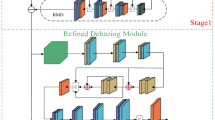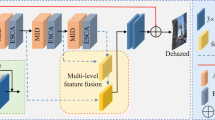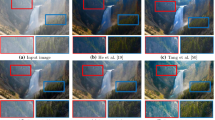Abstract
Existing image dehazing methods suffer from problems of insufficient dehazing, distortion, and low color contrast. Aiming at this problem, a deep learning single-image dehazing method based on multi-scale segmentation is proposed in this paper. The study found that the haze information in the haze image will decrease with the increase of frequency. Therefore, the haze image is first decomposed into four sub-images of different frequency domains through image segmentation in this article. A dehazing network model composed of four sub-network channels with different complexity is then constructed to extract the haze information contained in each sub-image. After the transmission sub-images are generated, the image fusion technology is used to obtain the final transmittance map. Finally, the haze-free image is obtained based on the physical model of atmospheric scattering. Experimental results on the synthetic and real images dataset show that the proposed method achieves significant dehazing effect and high color contrast with no distortion, showing superior performance than other dehazing methods.










Similar content being viewed by others
References
Cao, X.M., Liu, C.X., Zhang, J.D., et al.: Fast image dehazing algorithm based on luminance contrast enhancement. J. Comput. Aided Des. Comput. Graph. 30(10), 1925–1934 (2018)
Gao, Z.Z., Wei, W.B., Pan, Z.K., Hou, G.G., Zhao, H., Song, J.: Image dehazing based on second-order variational model. J. Comput. Aided Des. & Comput. Graph. 31(11), 1981–1994 (2019)
He, K. M., Sun, J., Tang, X. O.: Single image haze removal using dark channel prior[C]//2009. In: IEEE Conference on Computer Vision and Pattern Recognition, June 20–25, 2009, Miami, FL, USA. New York: IEEE, 2009 pp. 1956–1963
He, K.M., Sun, J., Tang, X.O.: Single image haze removal using dark channel prior. IEEE Trans Pattern Anal. Mach. Intell. 33(12), 2341–2353 (2011)
Lei, Q., Shi, C.J., Chen, T.T.: A single sea image dehazing method based on sky region segmentation. Comput. Eng. 41(05), 237–242 (2015)
Zeng, J.X., Yu, Y.L.: Image edge preserving and dehazing algorithm combining bilateral filtering and dark channel. J. Image Graph. 22(2), 147–153 (2017)
Kim, T.K., Paik, J.K., Kang, B.S.: Contrast enhancement system using spatially adaptive histogram equalization with temporal filtering. IEEE Trans. Consum. Electron. 44(1), 82–87 (1998)
Land, E.H.: An alternative technique for the computation of the designator in the retinex theory of color vision. Nat. Acad. Sci. 83(10), 3078–3080 (1986)
Mai J, Zhu Q, Wu D, et al.: Back propagation neural network dehazingIn: Proceedings of the IEEE International Conference on Robotics & Biomimetics, Bali, Indonesia: IEEE, pp. 1433–1438 (2014)
Ren W, Si L, Hua Z, et al. : Single image Dehazing via multi-scale convolutional neural networks. In: Proceedings of the European Conference on Computer Vision, Springer, German, pp. 154–169 (2016)
Cai, B.L., Xu, X.M., Jia, K., et al.: DehazeNet: an end-to-end system for single image haze removal. IEEE Trans. Image Process. 25(11), 5187–5198 (2016)
Chen D, He M, Fan Q, et al.: Gated context aggregation network for image dehazing and deraining. In: 2019 IEEE Winter Conference on Applications of Computer Vision (WACV). IEEE, pp. 1375-1383 (2019)
Zhang, X., Lou, X.P., Huang, Z.Y., et al.: A multi-scale parallel residual network for image dehazing. Opt. Tech. 46(06), 707–711 (2020)
Liu, S.Y., Zhang, Z.J., Lei, B.: Research on image dehazing algorithm based on BP-Net network structure. Opt & Optoelectron Technol. 18(06), 46–52 (2020)
Li, X.W., Yuan, T.S.: A dehazing algorithm based on cyclic generative confrontation network. J. Southwest China Normal Univ. (Nat. Sci. Ed.) 45(09), 132–138 (2020)
Cox, L.J.: Optics of the atmosphere-scattering by molecules and particles. Opt. Acta Int J. Opt. 24(7), 779 (1977)
Yang, A.P., Wang, H.X., Wang, J.B., et al.: Image dehazing based on transmission fusion and multi-guided filtering. Acta Opt. Sin. 38(12), 1210001 (2018)
Hu, C.S., Zhan, S., Wu, C.Z.: Image superresolution based on deep learning features. Acta Autom. Sin 43(5), 814–821 (2017)
Sun, Y. H.: Research and realization of image clearing method in haze. In: Xi'an: Xi'an University of Science and Technology, pp. 18–20 (2018)
Xu, Y., Sun, M.S.: Convolution neural network image Dehazing based on multi-feature fusion. Laser Optoelectronics Progr. 55(3), 260–262 (2018)
Author information
Authors and Affiliations
Corresponding author
Additional information
Publisher's Note
Springer Nature remains neutral with regard to jurisdictional claims in published maps and institutional affiliations.
Rights and permissions
About this article
Cite this article
Yu, T., Zhu, M. & Chen, H. Single image dehazing based on multi-scale segmentation and deep learning. Machine Vision and Applications 33, 33 (2022). https://doi.org/10.1007/s00138-022-01285-y
Received:
Revised:
Accepted:
Published:
DOI: https://doi.org/10.1007/s00138-022-01285-y




